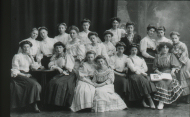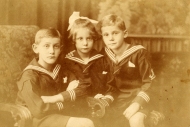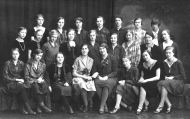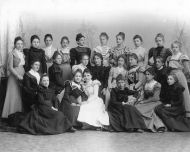|
|
|
|
|
|
|
|
|
|
|
|
|
|
|
|
|
|
|
|
|
|
|
|
|
|
|
|
|
|
|
|
|
|
|
|
|
|
|
|
|
|
|
|
|
|
|
|
|
|
|
|||||||||||||||||||||||||||||||||||||||||
|
Anna Gerstle Born: 1891 in Augsburg. Father’s occupation: businessman. Address: D 216 Annastraße. Anna (“Aennie”) Gerstle was the only child of Hermann Gerstle (b. 1854 in Steppach, near Augsburg) and Kathy (“Ketty”), née Oppenheimer (b. 1863 in New York). Anna was a cousin of Klara Berberich. Anna attended the “Municipal School for Daughters” (“Städtische Töchterschule”), which later was to be called “Maria-Theresia-School”, from 1903 to 1907 in classes 2–5; the fifth class was the school-leaving class in those times. Hermann Gerstle had, together with his brother Albert, founded a factory for women’s coats in 1885 (“H & A Gerstle”). Fritz Hirsch from Cologne (b. 1877) was his successor in charge of the company, Anna married him in 1913. But Hermann Gerstle outlived his son-in-law, who already died in 1930. Anna’s mother, Kathy, died in 1916, Anna’s father, Hermann, in 1938. In 1939 Anna emigrated to England together with her youngest daughter, Irmgard (b. 1922); her other two daughters, Margot and Käthe Hirsch, had emigrated to Palestine and England, respectively, even earlier. Anna worked as an au pair at first, then at the headship of a Refugee Children’s Home in Manchester, where 30 Jewish children who had been rescued from Germany and Austria by a children’s transport were looked after. Anna Hirsch, née Gerstle, died in January 1954 in England at her daughter Margot’s place. Source: Irmgard Hirsch-Erlund, Irmgard. Eine jüdische Kindheit in Bayern und eine Vertreibung, ed. Gernot Römer, Augsburg, 1999. |
|
Margareta Ginsberg Born: 1889 in King William’s Town, South Africa. Father’s occupation: factory owner in King William’s Town. Margareta’s father, Franz Ginsberg (b. 1862), came from Beuthen in Upper Silesia, her mother, Hedwig (b. 1867), was an offspring of the Rieser family from Ichenhausen, Swabia. Franz emigrated to South Africa; in King William’s Town, during the 1880s, he founded three factories which produced matches, soap and candles. In 1888, Franz married Hedwig Rieser in Rouxville. He traded in diamonds. From 1904 to 1907 he was the mayor of King William’s Town, which had almost 10,000 inhabitants at that time, two thirds of whom were white. Franz also was a member of the Parliament and, later, of the Union Senate. He died in 1936, his wife, Hedwig, in 1955. The couple had three children, Margareta (“Gretel”) was the first. In 1902/03 she joined class 2 of the “Municipal School for Daughters” (“Städtische Töchterschule”), which later was to be called “Maria-Theresia-School”. On a trip to Europe, the Ginsberg family arrived at Augsburg on December 29, 1902, and left the town after exactly seven months, on July 29, 1903. Gretel’s maternal grandmother, Clothilde Rieser, née Wimpfheimer (b. 1841), lived in Augsburg. The departure of her relatives is noted in her diary. In South Africa, Margareta married the lawyer Alfred Friedlander (b. 1881). One of their sons, Richard Friedlander, became the mayor of Cape Town, where the family lived. Margareta and her husband both died in 1964. |
|
|
|
Karola Goldstein Born: 1920. Father’s occupation: businessman. Karola’s mother was called Hedwig Goldstein. Karola attended Maria-Theresia-School from 1931 to 1935 in classes 1–4. 14-year-old Karola left the school without graduating on April 5, 1935. She emigrated to the USA. |
|
|
Elsbeth Guggenheimer Born: 1914 in Augsburg. Father’s occupation: businessman. Address: 1 Beethovenstraße. Elsbeth’s father, Julius A. Guggenheimer (b. 1878 in Hürben), was a businessman dealing in leather. His wife was called Anna, née Bruell (b. 1890 in Bamberg). Elsbeth attended Maria-Theresia-School from 1924 to 1928 in classes 1–3; she had to repeat class 2. In 1935, Elsbeth married the dentist Rolf Fabian (b. 1907 in Augsburg), son of Gisela Guggenheimer. In 1936, the couple emigrated to Palestine and lived in Rehovot, to the south of Tel Aviv. Elsbeth gave birth to a daughter. Elsbeth Fabian, née Guggenheimer, died in Rehovot, Israel, in 1990. Elsbeth’s twin brother, Ernest, emigrated to the USA, her brother Ludwig (b. 1905) to Switzerland. Elsbeth’s mother, Anna Guggenheimer, had to do forced labour in the Augsburg balloon factory, as so many other Jewish girls and women, from April 1942 to the beginning of March 1943. She and her husband, Julius, hat to move to a so-called “Jewish house” (“Judenhaus”) in Bahnhofstraße 18 1/5. Both of them committed suicide on March 7, 1943, together with their friends, the couples Englaender and Friedmann, shortly before their imminent deportation to Auschwitz (see the biographies of Elisabeth Englaender and Anna Friedmann). Source: Elisabeth König, “Gespräch mit Frau Hannah Gaywood, geb. Fabian, im Herbst 2004 in Genf,” Peter Wolf, ed., Spuren. Die jüdischen Schülerinnen und die Zeit des Nationalsozialismus an der Maria-Theresia-Schule Augsburg. Ein Bericht der Projektgruppe “Spurensuche” des Maria-Theresia-Gymnasiums, Augsburg, 2005, p. 57. |
|
|
Gisela Guggenheimer Born: 1887 in Augsburg. Father’s occupation: businessman or trader. Gisela’s father was Sigmund Guggenheimer (b. 1855 in Harburg), her mother was Betti, née Gunz (b. 1863 in Fischach). Gisela attended the “Municipal School for Daughters” (“Städtische Töchterschule”), which later was to be called “Maria-Theresia-School”, from 1899 to 1903 in classes 1–4; the fourth class was the school-leaving class in those times. Gisela married the dentist Julius Fabian (b. 1880 in Stuttgart). He was Chairman of the Augsburg section of the “Central Organisation of German Jewish Citizens” (“Centralverein deutscher Staatsbürger jüdischen Glaubens”) and an active member of several other organisations. The couple had a son, Rolf Fabian (b. 1907), who took over his father’s profession. He married Elsbeth Guggenheimer in 1935 so that Gisela became mother-in-law by the same surname. From 1933 on, when the National Socialists came to power, Julius and Rolf were no longer allowed to treat any patients in their joint practice covered by the Public Insurance scheme. Julius had to endure “protective custody” in March 1933 and one month of imprisonment in the Dachau concentration camp. In 1935, he was accused of having charged fees for treatments not rendered. One month after his son’s marriage, he shot himself when he had to face another imprisonment. Gisela emigrated in 1939; because she had been refused entry to Palestine, she went to England as a housekeeper. In 1946, she finally was allowed to move to Palestine. In 1949, she moved again, this time to the USA, where she worked until the age of 70. In 1957, she returned to Israel. During her last years she was ill with Parkinson’s disease. Gisela Fabian, née Guggenheimer, died in an old-age home at the outskirts of Tel-Aviv in 1961. |
|
|
Ilse Gunz Born: 1912 in Augsburg. Father’s occupation: Counsellor of Justice (“Justizrat”). llse’s parents were Eugen Gunz (b. 1874 in Augsburg) and Dora, née Rosenstrauss (b. 1887). Ilse had a younger brother, Franz (b. 1914). Ilse attended Maria-Theresia-School from 1924 to 1928 in classes 3–6; presumably, she had joined the school in class 1 in 1922. From 1929 to 1935, Ilse was an office worker at the department store “Brüder Landauer” in Augsburg. In 1935, she went to Berlin and had herself trained as a nurse at the Jewish hospital. She emigrated to England in 1939, where she kept on working as a nurse. Ilse Gunz died in London in 2002. In 1938 Ilse’s father, Eugen Gunz, was debarred as a lawyer, together with four colleagues in Augsburg. He and his wife, Dora, were deported from Augsburg in March 1943, presumably to Auschwitz, and are regarded as missing in the East. Ilse’s brother, Franz, emigrated to Palestine in 1935. He died in Israel in 2001. Sources and further reading: Reinhard Weber, Das Schicksal der jüdischen Rechtsanwälte in Bayern nach 1933, Munich, 2006, p. 233 (on Eugen Gunz). Susanne Rieger and Gerhard Jochem, website The Exclusion of Jewish Lawyers in Bavaria in December 1938: http://www.rijo.homepage.t-online.de/pdf/EN_BY_JU_anwalt02.pdf (as of May 2008). |
Sophie Günzburger Born: 1898 in Augsburg. Father’s occupation: businessman. Sophie’s father was Samuel Günzburger (b. 1866 in Pfersee, near Augsburg), her mother was Flora, née Richheimer (b. 1875 in Mannheim). Sophie attended the “Municipal School for Daughters” (“Städtische Töchterschule”), which from 1914 on was called “Maria-Theresia-School”, from 1909 to 1915, at first in classes 1–5 (skipping the second class), then in class 6 of the “Realabteilung”, and, at last, in 1914/15, in the “school for women”. After finishing school, Sophie worked as a laboratory technician. In 1920, she married the medical resident Julius Nördlinger, who worked in Augsburg. Sophie died in 1921, a few months after her marriage. Sophie’s father, Samuel, died in 1924 in Berlin, her mother, Flora, died around 1940. Aside: Sophie’s full first name was “Susi(e) Sophie”. According to several documents, “Susi(e)” was the forename by which she was generally known. |
|
Thea Günzburger Born: 1918 (no place of birth is given in the Annual School Reports). Father’s occupation: businessman. Residence: 19 Schaezlerstraße. Store: Karlstraße, at the corner of Karolinenstraße. Thea’s parents were Julius Günzburger (b. 1880 in Augsburg) and Paula, née Würzburger (b. 1889 in Karlsruhe). Julius was co-owner of the “Braumann & Günzburger Textile Department Store” and, from 1914 on, headed the independent Branch Store for Women’s Ware, in the “Weberhaus”, until it had to be reunited once again with the main store in 1929. Thea had three elder brothers: Hans (1911–76), Fritz (1914–93), and Ernst (1916–96). Thea attended Maria-Theresia-School from 1928 to 1934 in classes 1–6. In 1935, Thea went to Berlin-Weißensee to have herself trained as a nurse; she looked after deaf-mute children. In 1939, Thea emigrated with her parents to Brazil, where a brother of her father had an orchid farm. Her brothers also emigrated to Brazil. Her brother Ernst was in love with Gertrud Weil, who had to remain behind in Augsburg. In 1940, Ernst married Gertrud in a long-distance marriage, without being able to rescue her. Thea married Gerd Mordstein (b. 1905 in Berlin) and had two childern. She kept on looking after deaf-mute children. Thea Mordstein, née Günzburger, died in Rio de Janeiro in 1988. Thea’s father, Julius, died in Brazil in 1957, her mother, Paula, died in 1977 in Dayton, Ohio, where Thea’s brother Fritz had transferred to after the war. |
|
Ida Gutmann Born: 1883 in Augsburg. Father’s occupation: trader. Ida’s parents were Moritz Gutmann (b. 1851 in Hainsfarth), a trader of leather goods, and Jette, née Rosenfels (b. 1860 in Dormitz, near Erlangen). Ida attended the “Municipal School for Daughters” (“Städtische Töchterschule”), which later was to be called “Maria-Theresia-School”, from 1895 to 1899 in classes 1–4; the fourth class was the school-leaving class in those times. In 1906, Ida married in Augsburg the trader Isaak Schwab (b. 1872) from Fürth, son of Isaak Schwab (b. 1833) and Kehla Karoline, née Heller (b. 1845). The German citizenship of Ida’s husband was revoked. Presumably, the couple emigrated to England; in any case, Ida Schwab lived in London in 1948. Ida’s father, Moritz Gutmann, died in Augsburg in 1932, his widow Jette in Fürth in 1941. Ida’s brother Leopold (b. 1888) was deported to Piaski, Poland, in the beginning of April 1942. |






